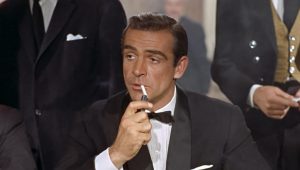Remembering Sean Connery
November 4, 2020
Sean Connery, known for originating the role of James Bond in 1962’s “Dr. No,” passed away at the age of 90 on Oct. 31. Connery is most known for his seven performances as James Bond, but he was also famous for his appearances in “Indiana Jones and the Last Crusade,” “Murder on the Orient Express” and an Oscar-winning performance in “The Untouchables.”
While the name Sean Connery may be lost on some younger people, it is undeniable that his early works both influenced and set the standards for decades of film and television to come.
Beyond just influencing spy films, both serious and parodic alike, with his signature suits and suave style, Connery, in many ways, originated the modern action hero.

Before Bond, the archetypal film hero was tough-as-nails, a person jaded by the world around them that was often riddled with moral complexity, but Connery rewrote the script with his introduction of a hero who was almost impossibly, for the lack of a more elegant term, badass.
From the moment of his iconic introduction (“Bond… James Bond”), Connery’s Bond was slick, lethal, desirable, witty and charming. He was a man who could defy death, get the girl and beat the bad guy, all at one-to-100 odds, and not even bat an eye.
No longer was the hero sulking and pondering, he was just having a good time, one liners and all. Connery perhaps peaked as Bond in 1964s “Goldfinger,” where the titular hero was as self-assured and cunning as he would ever be.
In the first four minutes of the film, Bond infiltrates a heroin plant in a scuba suit, blows up the plant, takes off the scuba suit to reveal a white suit, brings a dancer back to his room, kills an assassin and drops a one-liner.
Despite the fact that 22 Bond films have been released since “Goldfinger,” few have even come close to being as memorable as the franchise’s third installment. Connery’s iconic performances in the 1960s served as a bridge between the cynical and jaded protagonists of ‘40s and ‘50s noir and the blockbuster heroes that would begin to emerge in the late ‘70s.
As Daniel Craig, the current James Bond, put it in an interview with the 007 website, “He defined an era and a style. The wit and charm he portrayed on screen could be measured in megawatts; he helped create the modern blockbuster.”
Above all else, it was Connery’s ability to portray all of this with such ease that helped the Bond franchise become that cultural icon that it remains to this day. But, as he himself was adamant about, Connery was more than Bond.
Both during and after his Bond years, Connery, partially in an effort to not be condemned to typecasting for the rest of his career, broadened his horizons and worked with many acclaimed directors and rarely failed to elevate their work.
Overall, it was Connery’s ability to take on any role, and be so enthusiastic about it, that led to his post-Bond success.
This era of his career saw Connery take on a large variety of roles, but his presence on the screen was always powerful and often unmissable due to his ever-present Scottish accent.
Some of his standout roles in this second phase of his career were Colonel Arbuthnot in Sidney Lumet’s “Murder on the Orient Express,” Captain Marko Ramius in “The Hunt for Red October” and Daniel Dravot, a man mistaken to be a god by the people of a foreign land, in “The Man Who Would Be King.”
Connery also managed to earn himself an Oscar for best supporting actor in 1987 for playing the role of detective Jim Malone in “The Untouchables,” a role that also won him the honor of “worst movie accent of all time” by Empire magazine in 2003.
The role that I am most fond of, as it was my introduction to Connery, is his performance as Henry Jones, Sr. in “Indiana Jones and the Last Crusade.”
While the performance may not be as serious as the aforementioned ones, Connery’s ability to bring the character to life and portray them in such a clever and endearing way is a pleasure to watch.
There is also just something so lovable about how meta the casting choice of Connery is. Seeing him make an appearance in a franchise whose main character is so heavily inspired by the James Bond that he originated is pure, self-referential fun.
Connery may now be gone, but his larger-than-life legacy lives on through his iconic performances and monumental influence on popular culture.













